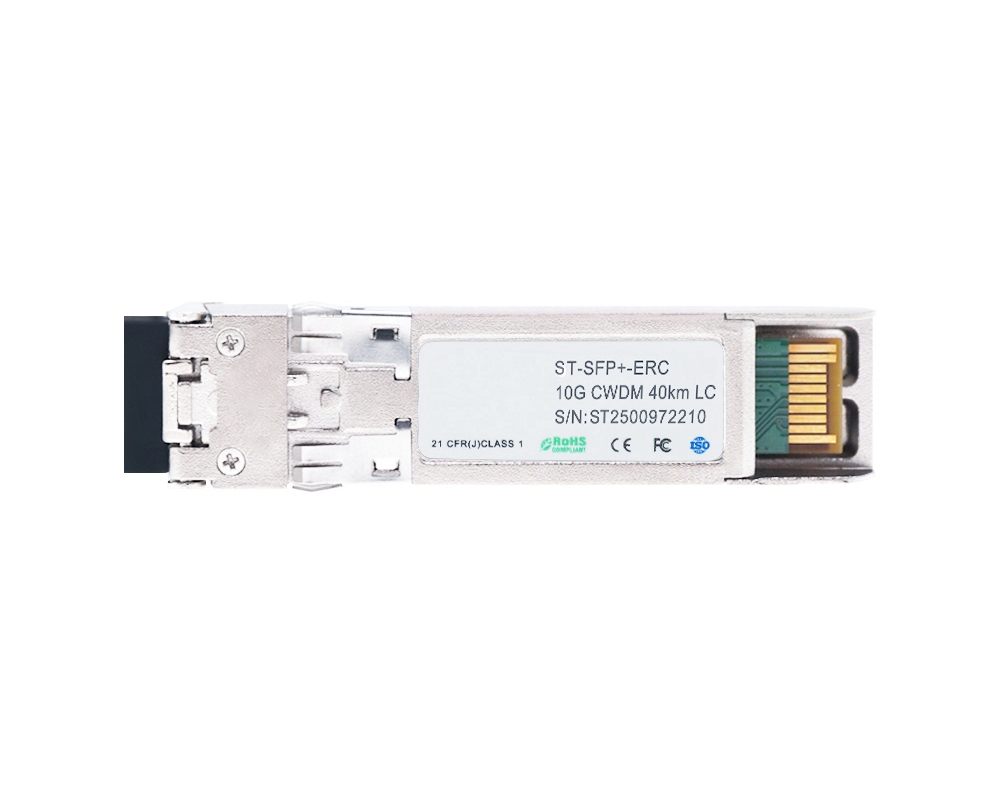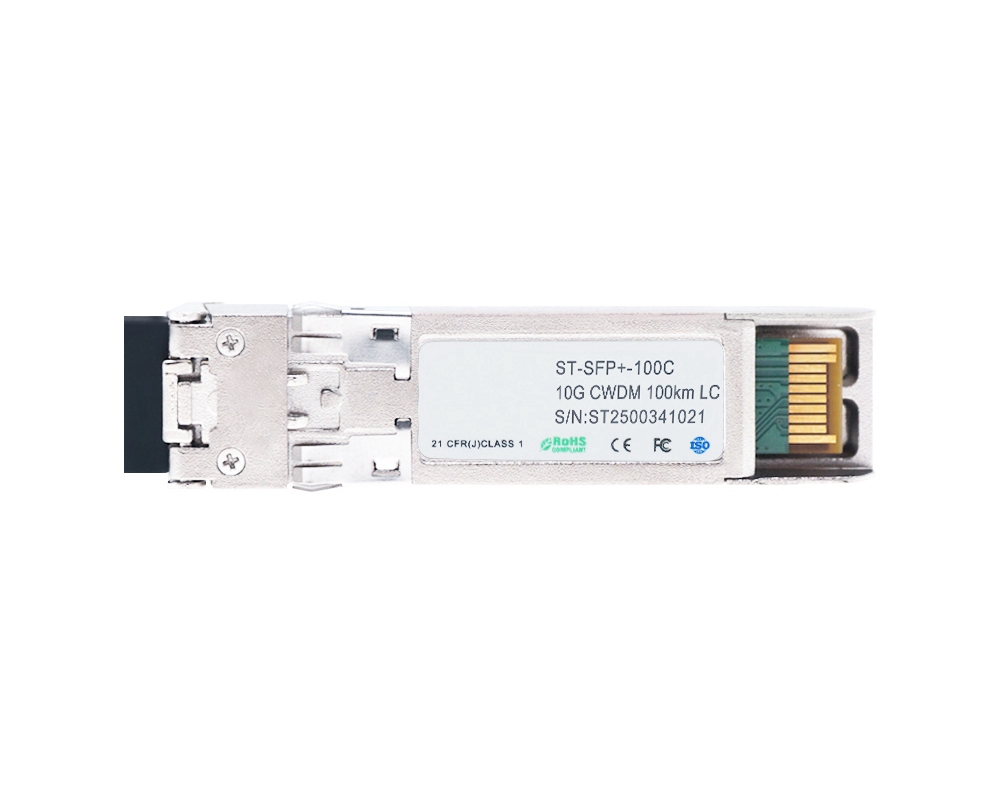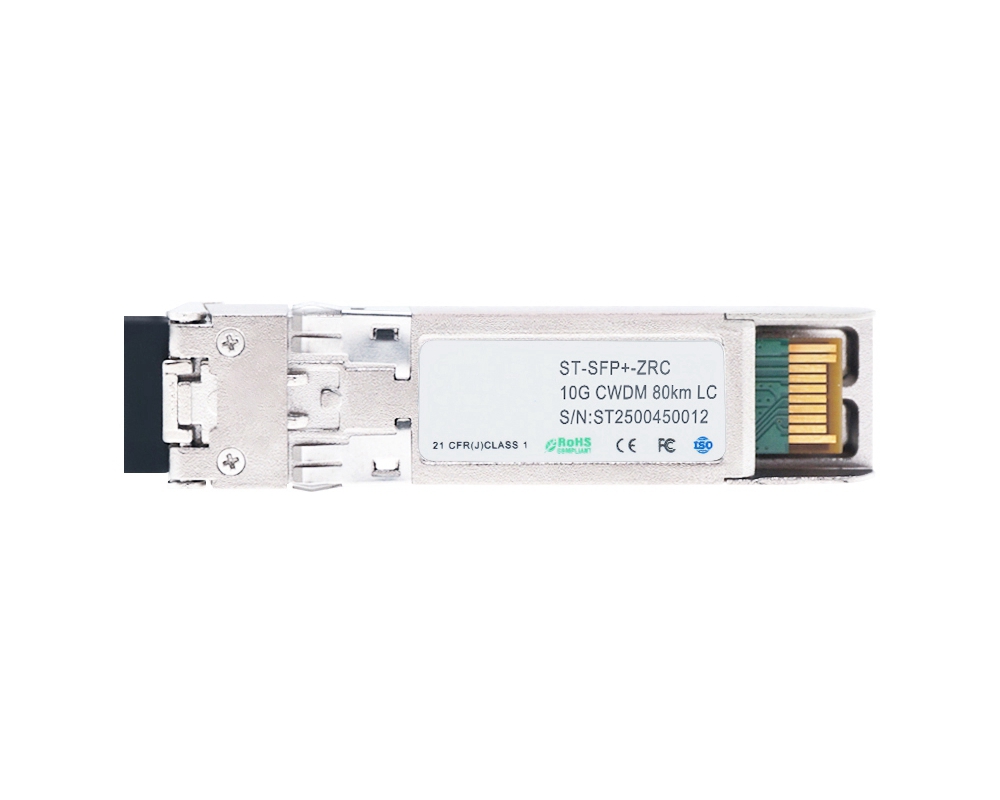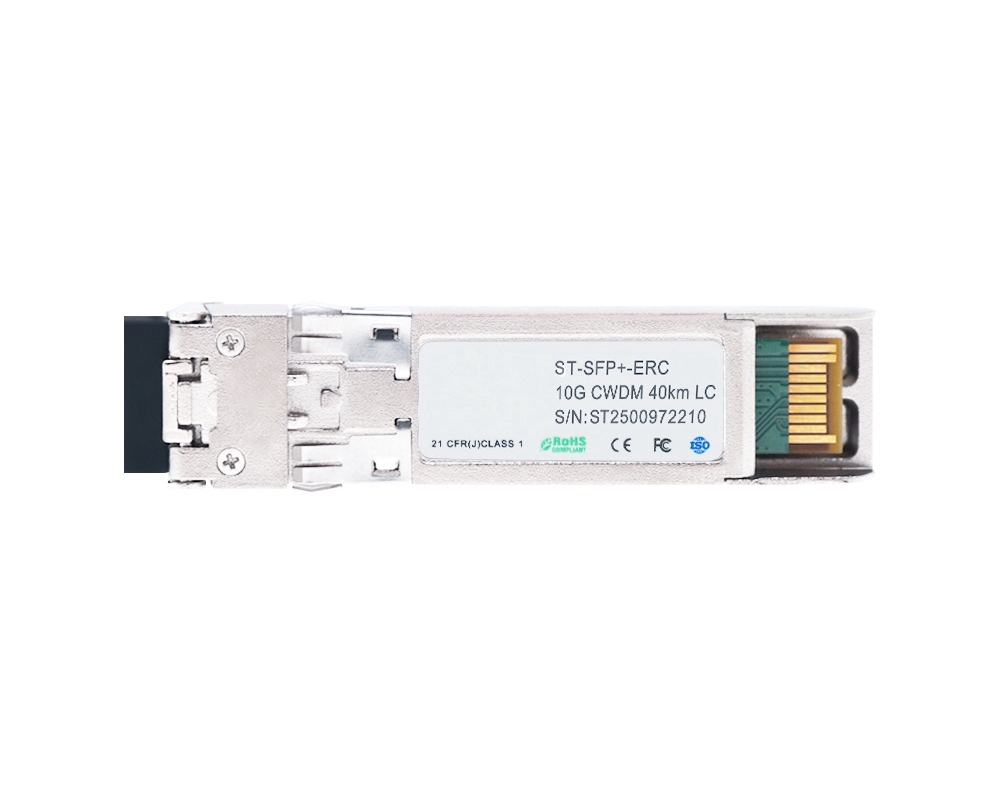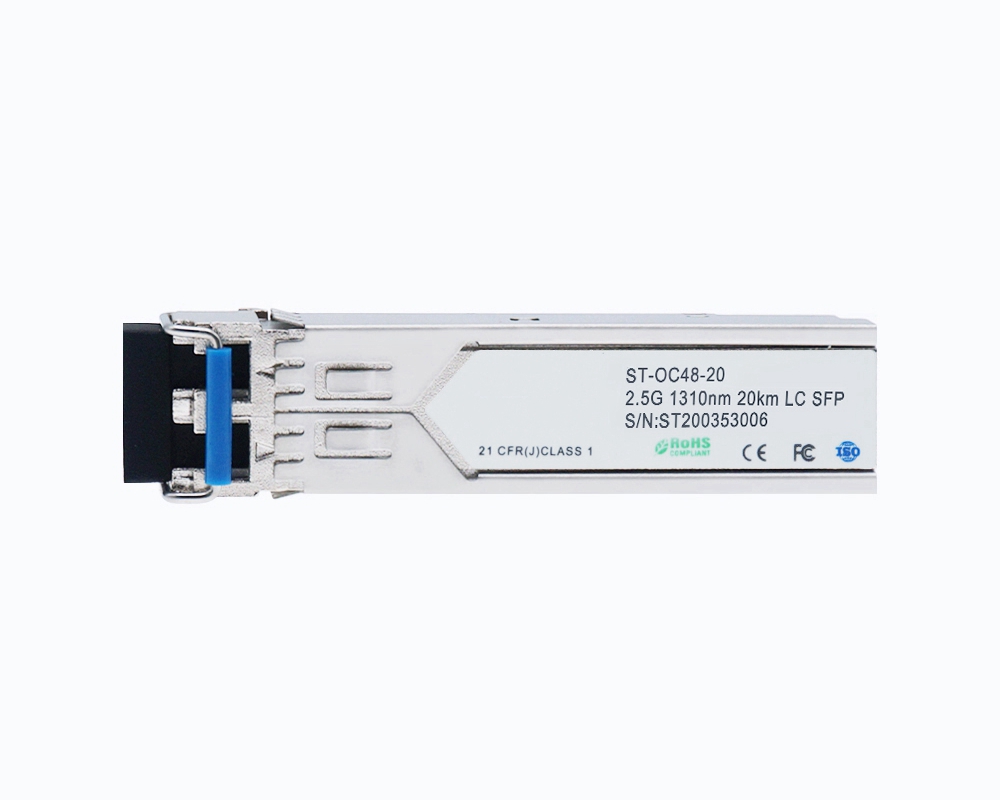Products+
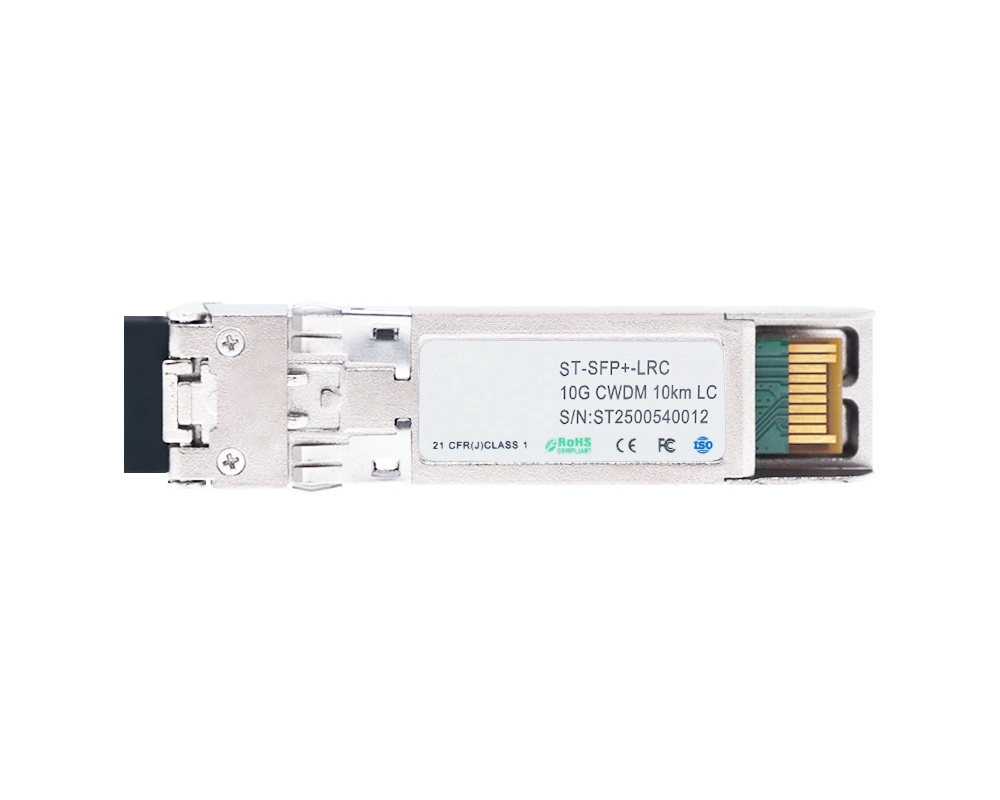
10G SFP+ CWDM LR 10KM Compatible Transceiver
This CWDM DFB 10Gigabit SFP+ transceiver is designed to transmit and receive optical data over single mode optical fiber for link length 10km, fully tested compatible for over 100 vendors.
Features
* Optical interface compliant to IEEE 802.3ae 10GBASE-LR
* Electrical interface compliant to SFF-8431
* Hot Pluggable
* 4-Wavelengths CWDM DFB transmitter from 1270nm to 1330nm, PIN photo-detector
* Operating case temperature: 0 to 70 °C
* Low power consumption
* Applicable for 10km SMF connection
* All-metal housing for superior EMI performance
* Advanced firmware allow customer system encryption information to be stored in transceiver
* Cost effective SFP+ solution, enables higher port densities and greater bandwidth
Applications
* 10GBASE-LR at 10.3125Gbps
* 10GBASE-LW at 9.953Gbps
* Other optical links
Product description
This CWDM DFB 10Gigabit SFP+ transceiver is designed to transmit and receive optical data over single mode optical fiber for link length 10km.
The CWDM SFP+ LR module electrical interface is compliant to SFI electrical specifications. The transmitter input and receiver output impedance is 100 Ohms differential. Data lines are internally AC coupled.
The module provides differential termination and reduce differential to common mode conversion for quality signal termination and low EMI.
SFI typically operates over 200 mm of improved FR4 material or up to about 150mmof standard FR4 with one connector. In the transmit direction, the SFP+ transceiver module receives a 10.3125 Gb/s electrical signal (signaling rate) from the host board Asic/SerDes and converts the data to an optical signal via the Laser Driver that controls the Laser diode in the Transmitter Optical Sub-Assembly (TOSA). An open collector compatible Transmit Disable (Tx_Dis) is provided.
A logic “1,” or no connection on this pin will disable the laser from transmitting. A logic “0” on this pin provides normal operation. The transmitter has an internal automatic power control loop (APC) to ensure constant optical power output across supply voltage and temperature variations.
An open collector compatible Transmit Fault (TFault) is provided. TX_Fault is a module output contact that when high, indicates that the module transmitter has detected a fault condition related to laser operation or safety. The TX_Fault output contact is an open drain/collector and shall be pulled up to the Vcc_Host in the host with a resistor in the range 4.7-10 kΩ. TX_Disable is a module input contact. When TX_Disable is asserted high or left open, the SFP+ module transmitter output shall be turned off. This contact shall be pulled up to VccT with a 4.7 kΩ to 10 kΩ resistor.The receiver converts 10Gbit/s serial optical data into serial PECL/CML electrical data.
An open collector compatible Loss of Signal is provided. Rx_LOS when high indicates an optical signal level below that specified in the relevant standard. The Rx_LOS contact is an open drain/collector output and shall be pulled up to Vcc_Host in the host with a resistor in the range 4.7-10 kΩ, or with an active termination. Power supply filtering is recommended for both the transmitter and receiver.
The Rx_LOS signal is intended as a preliminary indication to the system in which the SFP+ is installed that the received signal strength is below the specified range. Such an indication typically points to non-installed cables, broken cables, or a disabled, failing or a powered off transmitter at the far end of the cable.The 3rd functional capability of the SFP+ module is the 2 wire serial, I2C, interface. I2C is used for serial ID, digital diagnostics, and module control functions.
The enhanced digital diagnostics monitoring interface allows real time access to the device allowing monitor of received optical power, laser bias current, laser optical output power, etc.
Figure 1: Interface to Host
Pin definition
The SFP+ modules are hot-pluggable. Hot pluggable refers to plugging in or unplugging a module while the host board is powered. The SFP+ host connector is a 0.8 mm pitch 20 position right angle improved connector specified by SFF-8083, or stacked connector with equivalent with equivalent electrical performance. Host PCB contact assignment is shown in Figure 2 and contact definitions are given in Table 2. SFP+ module contacts mates with the host in the order of ground, power, followed by signal as illustrated by Figure 3 and the contact sequence order listed in Table 2.
Figure 3: Module Contact Assignment
Table 2: SFP+ Module PIN Definition
Absolute maximum rating
These values represent the damage threshold of the module. Stress in excess of any of the individual Absolute Maximum Ratings can cause immediate catastrophic damage to the module even if all other parameters are within Recommended Operating Conditions.
|
Parameters |
Symbol |
Min. |
Max. |
Unit |
|
Power Supply Voltage |
VCC |
0 |
+3.6 |
V |
|
Storage Temperature |
Tc |
-40 |
+85 |
°C |
|
Operating Case Temperature |
Tc |
0 |
+70 |
°C |
|
Relative Humidity |
RH |
5 |
95 |
% |
|
RX Input Average Power |
Pmax |
- |
0 |
dBm |
Recommended operating environment
Recommended Operating Environment specifies parameters for which the electrical and optical characteristics hold unless otherwise noted.
|
Parameter |
Symbol |
Min. |
Typical |
Max |
Unit |
|
Power Supply Voltage |
VCC |
3.135 |
3.300 |
3.465 |
V |
|
Operating Case Temperature |
TC |
0 |
25 |
70 |
°C |
Optical characteristics
The following optical characteristics are defined over the Recommended Operating Environment unless otherwise specified.
|
|
Unit |
Values |
|
Operating Reach |
m |
10KM |
|
Transmit |
||
|
Center wavelength (range) |
nm |
1270 -1330 |
|
Side Mode Suppression Ratio (min) |
dB |
30 |
|
Launched power |
||
|
– maximum |
dBm |
+0.5 |
|
– minimum |
dBm |
-8.2 Notes1 |
|
- OMA |
dBm |
-5.2 |
|
- OMA-TDP (min) |
dBm |
-6.2 |
|
Transmitter and dispersion penalty |
dB |
0 Notes4 |
|
Average launch power of OFF transmitter (max) |
dBm |
-30 |
|
Extinction ratio (min) |
dB |
3.5 Notes2 |
|
RIN12 OMA (max) |
dB/Hz |
-128 |
|
Optical Return Loss Tolerance (min) |
dB |
12 |
|
Receiver |
||
|
Center wavelength (range) |
nm |
1260-1355 |
|
Receive overload (max) in average power1 |
dBm |
0.5 |
|
Receive sensitivity (min) in average power1 |
dBm |
-14.4 Notes3 |
|
Receiver sensitivity (max) in OMA (footnote 2) |
dBm |
-12.6 Notes3 |
|
Receiver Reflectance (max) |
dB |
-12 |
|
Stressed receiver sensitivity (max) in OMA2 |
dBm |
-10.3 |
|
Vertical eye closure penalty (min)3 |
dB |
2.2 |
|
Stressed eye jitter (min)2 |
UIp-p |
0.7 |
|
Receive electrical 3dB upper cutoff frequency (max) |
GHz |
12.3 |
|
Receiver power (damage, Max) |
dBm |
1.5 |
|
Notes: 1. The optical power is launched into SMF 2. Measured with a PRBS 231-1 test pattern@10.3125Gbps 3. Measured with a PRBS 231-1 test pattern@10.3125Gbps BER≤10-12 4. In G.652 and G.655(NDSF)
|
||
Electrical characteristics
The following electrical characteristics are defined over the Recommended Operating Environment unless otherwise specified.
|
Parameter |
Symbol |
Min. |
Typical |
Max |
Unit |
Notes |
|
Data Rate |
|
- |
10.3125 |
- |
Gbps |
|
|
Power Consumption |
|
- |
1200 |
1500 |
mW |
|
|
Transmitter |
||||||
|
Single Ended Output Voltage Tolerance |
|
-0.3 |
- |
4.0 |
V |
|
|
C common mode voltage tolerance |
|
15 |
- |
- |
mV |
|
|
Tx Input Diff Voltage |
VI |
400 |
|
1600 |
mV |
|
|
Tx Fault |
VoL |
-0.3 |
|
0.4 |
V |
At 0.7mA |
|
Data Dependent Input Jitter |
DDJ |
|
|
0.10 |
UI |
|
|
Data Input Total Jitter |
TJ |
|
|
0.28 |
UI |
|
|
Receiver |
||||||
|
Single Ended Output Voltage Tolerance |
|
-0.3 |
- |
4.0 |
V |
|
|
Rx Output Diff Voltage |
Vo |
300 |
|
850 |
mV |
|
|
Rx Output Rise and Fall Time |
Tr/Tf |
30 |
|
|
ps |
20% to 80% |
|
Total Jitter |
TJ |
|
|
0.70 |
UI |
|
|
Deterministic Jitter |
DJ |
|
|
0.42 |
UI |
|
Conrtol and status I/O timing characteristics
Timing characteristics of control and status I/O are included in Table 7, which is also defined in SFF-8431.



